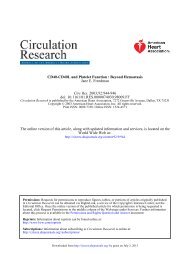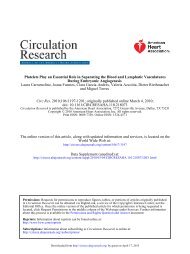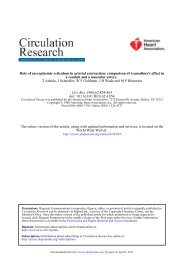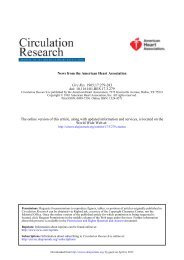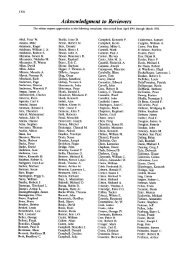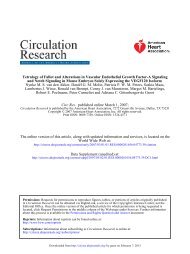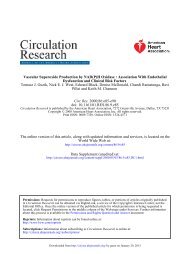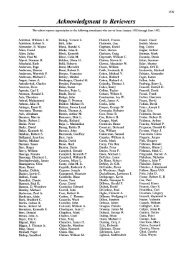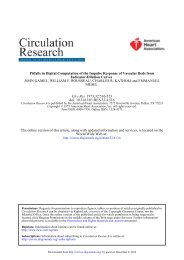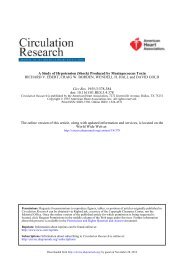New Methods in Cardiovascular Biology - Circulation Research
New Methods in Cardiovascular Biology - Circulation Research
New Methods in Cardiovascular Biology - Circulation Research
You also want an ePaper? Increase the reach of your titles
YUMPU automatically turns print PDFs into web optimized ePapers that Google loves.
Development of a Drug Screen<strong>in</strong>g Platform Based on Eng<strong>in</strong>eered Heart Tissue<br />
Arne Hansen, Alexandra Eder, Marlene Bönstrup, Marianne Flato, Marco Mewe, Sebastian<br />
Schaaf, Bülent Aksehirlioglu, Alexander Schwörer, June Uebeler and Thomas Eschenhagen<br />
Circ Res. 2010;107:35-44; orig<strong>in</strong>ally published onl<strong>in</strong>e May 6, 2010;<br />
doi: 10.1161/CIRCRESAHA.109.211458<br />
<strong>Circulation</strong> <strong>Research</strong> is published by the American Heart Association, 7272 Greenville Avenue, Dallas, TX 75231<br />
Copyright © 2010 American Heart Association, Inc. All rights reserved.<br />
Pr<strong>in</strong>t ISSN: 0009-7330. Onl<strong>in</strong>e ISSN: 1524-4571<br />
The onl<strong>in</strong>e version of this article, along with updated <strong>in</strong>formation and services, is located on the<br />
World Wide Web at:<br />
http://circres.ahajournals.org/content/107/1/35<br />
An erratum has been published regard<strong>in</strong>g this article. Please see the attached page for:<br />
http://circres.ahajournals.org/content/109/11/e54.full.pdf<br />
Data Supplement (unedited) at:<br />
http://circres.ahajournals.org/content/suppl/2010/05/06/CIRCRESAHA.109.211458.DC1.html<br />
Permissions: Requests for permissions to reproduce figures, tables, or portions of articles orig<strong>in</strong>ally published<br />
<strong>in</strong> <strong>Circulation</strong> <strong>Research</strong> can be obta<strong>in</strong>ed via RightsL<strong>in</strong>k, a service of the Copyright Clearance Center, not the<br />
Editorial Office. Once the onl<strong>in</strong>e version of the published article for which permission is be<strong>in</strong>g requested is<br />
located, click Request Permissions <strong>in</strong> the middle column of the Web page under Services. Further <strong>in</strong>formation<br />
about this process is available <strong>in</strong> the Permissions and Rights Question and Answer document.<br />
Repr<strong>in</strong>ts: Information about repr<strong>in</strong>ts can be found onl<strong>in</strong>e at:<br />
http://www.lww.com/repr<strong>in</strong>ts<br />
Subscriptions: Information about subscrib<strong>in</strong>g to <strong>Circulation</strong> <strong>Research</strong> is onl<strong>in</strong>e at:<br />
http://circres.ahajournals.org//subscriptions/<br />
Downloaded from<br />
http://circres.ahajournals.org/ by guest on December 5, 2012
<strong>New</strong> <strong>Methods</strong> <strong>in</strong> <strong>Cardiovascular</strong> <strong>Biology</strong><br />
Development of a Drug Screen<strong>in</strong>g Platform Based on<br />
Eng<strong>in</strong>eered Heart Tissue<br />
Arne Hansen,* Alexandra Eder,* Marlene Bönstrup, Marianne Flato, Marco Mewe, Sebastian Schaaf,<br />
Bülent Aksehirlioglu, Alexander Schwörer, June Uebeler, Thomas Eschenhagen<br />
Rationale: Tissue eng<strong>in</strong>eer<strong>in</strong>g may provide advanced <strong>in</strong> vitro models for drug test<strong>in</strong>g and, <strong>in</strong> comb<strong>in</strong>ation with<br />
recent <strong>in</strong>duced pluripotent stem cell technology, disease model<strong>in</strong>g, but available techniques are unsuitable for<br />
higher throughput.<br />
Objective: Here, we present a new m<strong>in</strong>iaturized and automated method based on eng<strong>in</strong>eered heart tissue (EHT).<br />
<strong>Methods</strong> and Results: Neonatal rat heart cells are mixed with fibr<strong>in</strong>ogen/Matrigel plus thromb<strong>in</strong> and pipetted <strong>in</strong>to<br />
rectangular cast<strong>in</strong>g molds <strong>in</strong> which two flexible silicone posts are positioned from above. Contractile activity is<br />
monitored video-optically by a camera and evaluated by a custom-made software program. Fibr<strong>in</strong>-based<br />
m<strong>in</strong>i-EHTs (FBMEs) (150 �L, 600 000 cells) were transferred from molds to a standard 24-well plate two hours<br />
after cast<strong>in</strong>g. Over time FBMEs condensed from a 12�3�3 mm gel to a muscle strip of 8 mm length and,<br />
depend<strong>in</strong>g on conditions, 0.2 to 1.3 mm diameter. After 8 to 10 days, FBMEs started to rhythmically deflect the<br />
posts. Post properties and the extent of post deflection allowed calculation of rate, force (0.1 to 0.3 mN), and<br />
k<strong>in</strong>etics which was validated <strong>in</strong> organ baths experiments. FBMEs exhibited a well-developed, longitud<strong>in</strong>ally<br />
aligned act<strong>in</strong><strong>in</strong>-positive cardiac muscle network and lect<strong>in</strong>-positive vascular structures <strong>in</strong>terspersed homogeneously<br />
throughout the construct. Analysis of a large series of FBME (n�192) revealed high yield and<br />
reproducibility and stability for weeks. Chromanol, qu<strong>in</strong>id<strong>in</strong>e, and erythromyc<strong>in</strong> exerted concentrationdependent<br />
<strong>in</strong>creases <strong>in</strong> relaxation time, doxorubic<strong>in</strong> decreases <strong>in</strong> contractile force.<br />
Conclusions: We developed a simple technique to construct large series of EHT and automatically evaluate contractile<br />
activity. The method shall be useful for drug screen<strong>in</strong>g and disease model<strong>in</strong>g. (Circ Res. 2010;107:35-44.)<br />
Key Words: cardiac tissue eng<strong>in</strong>eer<strong>in</strong>g � drug screen<strong>in</strong>g � predictive toxicology � automation<br />
Over the past decade, techniques have been developed to<br />
generate cardiac tissue-like 3D constructs <strong>in</strong> vitro. 1<br />
Tissue eng<strong>in</strong>eered myocardial constructs may serve as means<br />
for cell-based cardiac repair and as improved <strong>in</strong> vitro models<br />
for predictive toxicology and target validation, tak<strong>in</strong>g advantage<br />
of a more physiological cellular environment. Recent<br />
cardiac tissue eng<strong>in</strong>eer<strong>in</strong>g approaches <strong>in</strong>clude the use of<br />
solid, preformed scaffolds, 2–7 matrix-free generation of tissues<br />
from stackable cell sheets, 8 or the generation of constructs<br />
<strong>in</strong> preformed cast<strong>in</strong>g molds us<strong>in</strong>g hydrogels such as<br />
collagen I, Matrigel, fibronect<strong>in</strong>, or fibr<strong>in</strong>. 9–13 The pr<strong>in</strong>cipal<br />
usefulness of these techniques for cardiac repair14 and <strong>in</strong> vitro<br />
test<strong>in</strong>g15 has been demonstrated.<br />
Us<strong>in</strong>g circular cast<strong>in</strong>g molds and collagen I plus Matrigel<br />
to generate eng<strong>in</strong>eered heart tissue (EHT) from neonatal rat<br />
heart cells we have shown that EHT develop a high degree of<br />
cellular differentiation, longitud<strong>in</strong>al orientation, <strong>in</strong>tercellular<br />
coupl<strong>in</strong>g and force generation. 10 Tissue formation and force<br />
generation of EHT were improved by phasic 16 or auxotonic<br />
stretch, <strong>in</strong>creased oxygen concentration and supplementation<br />
with <strong>in</strong>sul<strong>in</strong>. 14 Others demonstrated beneficial effects of<br />
electric stimulation. 6 Recent methods to generate cardiac<br />
myocytes from human embryonic stem cells 17 or <strong>in</strong>duced<br />
pluripotent stem cells 18 have opened the realistic and excit<strong>in</strong>g<br />
perspective to use these techniques for the validation of<br />
hypotheses and test<strong>in</strong>g drugs <strong>in</strong> healthy and diseased human<br />
heart muscles. 19<br />
Yet, the exist<strong>in</strong>g techniques are either not suitable for this<br />
purpose (stacked cell sheet technique) or exhibit drawbacks<br />
that limit their usefulness. For example, the exist<strong>in</strong>g methods<br />
require extensive handl<strong>in</strong>g which precludes rout<strong>in</strong>e handl<strong>in</strong>g<br />
of large series and gives rise to experimental variability.<br />
Orig<strong>in</strong>al received October 16, 2009; revision received April 22, 2010; accepted April 28, 2010. In March 2010, the average time from submission to<br />
first decision for all orig<strong>in</strong>al research papers submitted to <strong>Circulation</strong> <strong>Research</strong> was 13.3 days.<br />
From the Department of Experimental and Cl<strong>in</strong>ical Pharmacology and Toxicology (A.H., A.E., M.B., M.F., S.S., B.A., J.U., T.E.), Institute of<br />
Pharmacology for Pharmacists (M.M.), and Institute of Physiology (A.S.), <strong>Cardiovascular</strong> <strong>Research</strong> Center, University Medical Center Hamburg-<br />
Eppendorf, Germany.<br />
*Both authors contributed equally to this work.<br />
Correspondence to Thomas Eschenhagen, Institute of Experimental and Cl<strong>in</strong>ical Pharmacology and Toxicology, University Medical Center<br />
Hamburg-Eppendorf, Mart<strong>in</strong>istrasse 52, 20246 Hamburg, Germany. E-mail t.eschenhagen@uke.de<br />
© 2010 American Heart Association, Inc.<br />
<strong>Circulation</strong> <strong>Research</strong> is available at http://circres.ahajournals.org DOI: 10.1161/CIRCRESAHA.109.211458<br />
Downloaded from<br />
http://circres.ahajournals.org/ 35 by guest on December 5, 2012
36 <strong>Circulation</strong> <strong>Research</strong> July 9, 2010<br />
Non-standard Abbreviations and Acronyms<br />
EHT eng<strong>in</strong>eered heart tissue<br />
FBME fibr<strong>in</strong>-based m<strong>in</strong>i–eng<strong>in</strong>eered heart tissue<br />
MHC myos<strong>in</strong> heavy cha<strong>in</strong><br />
SERCA sarcoplasmic reticulum Ca 2� /ATPase<br />
T1 contraction time<br />
T2 relaxation time<br />
Moreover, the collagen-based r<strong>in</strong>g EHT technique requires<br />
relatively high numbers of cells and is difficult to m<strong>in</strong>iaturize.<br />
The present study aimed at m<strong>in</strong>iaturiz<strong>in</strong>g the EHT format,<br />
multiwell-test<strong>in</strong>g, and automated evaluation. One of the key<br />
factors was exchang<strong>in</strong>g collagen I with fibr<strong>in</strong>(ogen). Fibr<strong>in</strong>ogen<br />
is a 340-kDa glycoprote<strong>in</strong>, which is present <strong>in</strong> blood<br />
plasma at concentrations of 1.5 to 4 g/L and can be readily<br />
purified from different species. Characteristic mechanical<br />
properties of fibr<strong>in</strong> polymer are its nonl<strong>in</strong>ear elasticity result<strong>in</strong>g<br />
<strong>in</strong> higher elastic modulus under shear stress and its<br />
softness <strong>in</strong> comparison to other filamentous biopolymers. 20<br />
The degree of softness and elasticity depends on several<br />
different factors like fibr<strong>in</strong>ogen concentration and <strong>in</strong>troduction<br />
of bonds by plasma transglutam<strong>in</strong>ase (factor XIII). 20 In<br />
contrast to other extracellular matrices, the <strong>in</strong> vitro polymerization<br />
of fibr<strong>in</strong> results <strong>in</strong> a gel which is very similar to <strong>in</strong><br />
vivo fibr<strong>in</strong> polymer. The gel is fully biodegradable by<br />
fibr<strong>in</strong>olytic enzyme plasm<strong>in</strong>. The availability of fibr<strong>in</strong>ogen<br />
from autologous sources, its degradability, the versatile mechanical<br />
characteristics and the ability to covalently b<strong>in</strong>d<br />
growth factors 21 make fibr<strong>in</strong> an <strong>in</strong>terest<strong>in</strong>g compound for<br />
tissue eng<strong>in</strong>eer<strong>in</strong>g applications.<br />
<strong>Methods</strong><br />
An expanded <strong>Methods</strong> section is available <strong>in</strong> the Onl<strong>in</strong>e Data<br />
Supplement at http://circres.ahajournals.org.<br />
Manufactur<strong>in</strong>g Sylgard Posts and Teflon Spacers<br />
Sylgard 184 silicone elastomer (Dow Corn<strong>in</strong>g) was used to produce<br />
silicone post racks <strong>in</strong> custom-made Teflon cast<strong>in</strong>g molds. The<br />
2-component Sylgard 184 elastomer was handled accord<strong>in</strong>g to<br />
manufactures <strong>in</strong>structions and degassed under vacuum conditions<br />
before cast<strong>in</strong>g. The racks conta<strong>in</strong>ed 4 pairs of posts and had the<br />
follow<strong>in</strong>g geometry (Figure 1A): length/width of rack: 79�18.5 mm,<br />
length of posts 12 mm, diameter 1 mm, plate diameter 2 mm,<br />
distance (center–center) 8.5 mm. They are currently autoclaved and<br />
reused. Teflon spacers for produc<strong>in</strong>g the cast<strong>in</strong>g molds (Figure 1B)<br />
had the follow<strong>in</strong>g geometry: length 12 mm, width 3 mm, height<br />
13.5 mm.<br />
Generation of Fibr<strong>in</strong>-Based M<strong>in</strong>i-EHTs<br />
To generate fibr<strong>in</strong>-based m<strong>in</strong>i-EHTs (FBMEs), a reconstitution<br />
mixture was prepared on ice as follows (f<strong>in</strong>al concentration):<br />
4.1�10 6 cells/mL, 5 mg/mL bov<strong>in</strong>e fibr<strong>in</strong>ogen (stock solution: 200<br />
mg/mL plus aprot<strong>in</strong><strong>in</strong> 0.5 �g/mg fibr<strong>in</strong>ogen <strong>in</strong> NaCl 0.9%, Sigma<br />
F4753), 100 �L/mL Matrigel (BD Bioscience 356235). DMEM<br />
(2�) was added to match the volumes of fibr<strong>in</strong>ogen and thromb<strong>in</strong><br />
stock to ensure isotonic conditions. Cast<strong>in</strong>g molds were prepared by<br />
plac<strong>in</strong>g the Teflon spacer <strong>in</strong> 24-well culture dishes and add<strong>in</strong>g 1.6<br />
mL 2% agarose <strong>in</strong> PBS (Invitrogen 15510-027) per well. After<br />
agarose solidification the spacer were removed (yield<strong>in</strong>g a cast<strong>in</strong>g<br />
mold of 12�3�4 mm) and silicon post racks were placed onto the<br />
dishes with pairs of posts reach<strong>in</strong>g <strong>in</strong>to each cast<strong>in</strong>g mold. For each<br />
FBME 145 �L reconstitution mix was mixed briefly with 4.5 �L<br />
thromb<strong>in</strong> (100 U/mL, Sigma Aldrich T7513) and pipetted <strong>in</strong>to the<br />
agarose slot.<br />
For fibr<strong>in</strong>ogen polymerization the constructs were placed <strong>in</strong> a<br />
37°C, 7% CO 2 humidified cell culture <strong>in</strong>cubator for 2 hours. Cell<br />
culture medium (300 �L) was then added per well to ease removal<br />
of the constructs from agarose cast<strong>in</strong>g molds. The racks were<br />
transferred to new 24-well cell culture dishes. Constructs were<br />
ma<strong>in</strong>ta<strong>in</strong>ed <strong>in</strong> 37°C, 7% CO 2 humidified cell culture <strong>in</strong>cubator.<br />
Media was changed on Mondays, Wednesdays and Fridays. EHT<br />
medium consisted of DMEM (Biochrom F0415), 10% horse serum<br />
(Gibco 26050), 2% chick embryo extract, 1% penicill<strong>in</strong>/streptomyc<strong>in</strong><br />
(Gibco 15140), <strong>in</strong>sul<strong>in</strong> (10 �g/mL, Sigma-Aldrich I9278),<br />
tranexamic acid (400 �mol/L, Sigma-Aldrich 857653), and aprot<strong>in</strong><strong>in</strong><br />
(33 �g/mL, Sigma Aldrich A1153).<br />
Video Optical Analysis<br />
The setup for video optical record<strong>in</strong>g consisted of a cell <strong>in</strong>cubator<br />
unit with control of CO 2, humidity and temperature, and a glass roof<br />
for monitor<strong>in</strong>g purposes. Light diodes were positioned underneath<br />
the cell culture dish. A Basler camera (Type A 602f-2) placed above<br />
the cell culture unit was positioned <strong>in</strong> XYZ direction (IAI Corporation)<br />
<strong>in</strong> a PC-controlled manner. Video optical record<strong>in</strong>g and light<br />
exposure were synchronized to m<strong>in</strong>imize heat<strong>in</strong>g of cell culture<br />
Figure 1. Illustration of the experimental setup for cast<strong>in</strong>g and cultivation of FBMEs and photograph of 1 silicone rack with 4<br />
FBMEs. A, Silicon post rack with four FBMEs, turned upside down, scale <strong>in</strong> millimeter. B, Teflon spacer to generate agarose cast<strong>in</strong>g<br />
molds, turned upside down, scale <strong>in</strong> millimeters. C, Illustration of FBME generation. First lane, Strip format cast<strong>in</strong>g molds are generated<br />
<strong>in</strong> 24-well cell culture dishes us<strong>in</strong>g agarose and Teflon spacers (B). Silicone racks are placed on the dish, pairs of posts reach <strong>in</strong>to<br />
each mold. Second lane, The mastermix (s<strong>in</strong>gle-cell suspension, Matrigel, fibr<strong>in</strong>ogen, and thromb<strong>in</strong>) is pipetted <strong>in</strong>to the molds. Third<br />
lane, Two hours later, the fibr<strong>in</strong> hydrogel is polymerized. The silicone posts are embedded <strong>in</strong> the hydrogel at both ends. The constructs<br />
are carefully removed from the molds and transferred to cell culture medium-conta<strong>in</strong><strong>in</strong>g 24-well cell culture dishes. Forth lane, The<br />
constructs are ma<strong>in</strong>ta<strong>in</strong>ed under cell culture conditions for 15 to 30 days.<br />
Downloaded from<br />
http://circres.ahajournals.org/ by guest on December 5, 2012
medium by light. Figure 2A illustrates the experimental setup. Figure<br />
2B shows a 24-well cell culture plate from above. Video optical<br />
analysis was performed with a customized software package by<br />
Consult<strong>in</strong>g Team Mach<strong>in</strong>e Vision (Pforzheim, Germany). The software<br />
is based on figure recognition of the contract<strong>in</strong>g muscle strip at<br />
top and bottom ends <strong>in</strong> a fully automated manner. The distance<br />
between the ends of the muscle strip is determ<strong>in</strong>ed dur<strong>in</strong>g contractions<br />
and recorded over time. Based on post geometry (diameter,<br />
length), elastic modulus of Sylgard 184 (2.6 kPa) and delta of post<br />
distance (post deflection) force was calculated accord<strong>in</strong>g to a<br />
recently published equation. 22 Recorded contractions are identified<br />
by peak criteria (threshold value, m<strong>in</strong>imum relaxation). Based on<br />
identified contractions, values for frequency, average force, fractional<br />
shorten<strong>in</strong>g, contraction – and relaxation time (T1, T2, respectively)<br />
were calculated. Records of experiments are automatically<br />
generated with two levels of quality control: pictures are taken at the<br />
beg<strong>in</strong>n<strong>in</strong>g and the end of each measurement and blue squares<br />
<strong>in</strong>dicate the positions on both ends of the muscle stripe (Figure 2C).<br />
Contractions are recorded as force development over time and green<br />
squares <strong>in</strong> the graph <strong>in</strong>dicate the identified peaks (Figure 2D and<br />
Onl<strong>in</strong>e Movie). The effort to analyze contractility with this setup is<br />
limited to def<strong>in</strong><strong>in</strong>g the x, y, z coord<strong>in</strong>ates of the camera for each<br />
FBME.<br />
Results<br />
General Aspects of the <strong>New</strong> Technique<br />
We present a new technique to generate FBMEs from<br />
neonatal rat heart cells. The technique is based on the<br />
preparation of a s<strong>in</strong>gle cell suspension <strong>in</strong> a fibr<strong>in</strong>ogen<br />
Hansen et al EHT-Based Screen<strong>in</strong>g Platform 37<br />
Figure 2. Illustration of the setup for video-optical record<strong>in</strong>gs of FBMEs, a 24-well dish with FBMEs, a magnified view of a s<strong>in</strong>gle<br />
FBME as recorded by the video camera, and an example of the recorded contractile activity of 1 FBME for 60 seconds. A,<br />
Schematic illustration of experimental setup for video-optical record<strong>in</strong>g. B, FBMEs <strong>in</strong> 24-well cell culture dish, view from above. C,<br />
Analysis report, live image of FBME. Blue squares <strong>in</strong>dicate positions, which are used to analyze FBME contraction. D, Graph shows<br />
contractions over time (60 seconds); green squares <strong>in</strong>dicate automatically identified contractions used for calculat<strong>in</strong>g total number of<br />
beats per m<strong>in</strong>ute, force, and times of contraction and relaxation. For live view, see the Onl<strong>in</strong>e Movie.<br />
conta<strong>in</strong><strong>in</strong>g mastermix. Strip format cast<strong>in</strong>g molds are prepared<br />
from agarose <strong>in</strong> 24-well cell culture dishes and pairs of<br />
silicone posts are positioned <strong>in</strong> each mold. After addition of<br />
thromb<strong>in</strong> the cell preparation is transferred to the molds.<br />
Fibr<strong>in</strong> polymerization leads to the development of a hydrogel<br />
which is fixed to the silicone posts at both ends. 2 hours later<br />
the constructs are transferred to new cell culture dishes and<br />
ma<strong>in</strong>ta<strong>in</strong>ed under cell culture conditions. Figure 1C illustrates<br />
this procedure.<br />
Over time of cultivation, the cells spread <strong>in</strong>side the matrix,<br />
form cell–cell contacts and remodel the hydrogel. This<br />
process leads to marked condensation of the construct and<br />
imposes mechanical load on the cells and bends the posts<br />
toward each other. The f<strong>in</strong>al length of FBMEs thus amounted<br />
on average to 6.3 mm compared to 8.5 mm on day 0 (see<br />
Results, force of contraction). This leads to “<strong>in</strong>dividually<br />
optimized preload” of each construct and straight force l<strong>in</strong>es<br />
with<strong>in</strong> the FBMEs. This simplified procedure allows the<br />
rout<strong>in</strong>e preparation of 48 to 72 FBMEs per cell preparation<br />
(30 neonatal rat hearts). Figure 2B illustrates a typical<br />
24-well plate. The absence of protease <strong>in</strong>hibitor aprot<strong>in</strong><strong>in</strong><br />
leads to a rapid degradation of the fibr<strong>in</strong> hydrogel (not<br />
shown). Addition of aprot<strong>in</strong><strong>in</strong> at a concentration of 33<br />
�g/mL markedly slowed this process, but did not entirely<br />
stop it. Stability could be enhanced by the addition of the<br />
Downloaded from<br />
http://circres.ahajournals.org/ by guest on December 5, 2012
38 <strong>Circulation</strong> <strong>Research</strong> July 9, 2010<br />
protease <strong>in</strong>hibitor tranexamic acid which allowed cultivation<br />
of FBMEs for extended periods of time (data not<br />
shown). The addition of tranexamic acid markedly slowed<br />
the reduction <strong>in</strong> diameter (f<strong>in</strong>al width 1.3 to 1.4 mm<br />
[Figures 2C and 6D] <strong>in</strong>stead of 0.2 to 1 mm <strong>in</strong> its absence<br />
[Figure 3A]).<br />
Morphology and Beat<strong>in</strong>g Activity<br />
Directly after cast<strong>in</strong>g, FBMEs appeared as soft and flexible<br />
rectangular blocks of gel between two silicone posts<br />
(12�3�3 mm). The gel conta<strong>in</strong>ed evenly distributed amorphous<br />
round heart cells (Onl<strong>in</strong>e Figure I, A). With<strong>in</strong> days,<br />
cells elongated, aligned along force l<strong>in</strong>es, and started to beat<br />
as s<strong>in</strong>gle cells at day 4 to 5. Degradation and remodel<strong>in</strong>g of<br />
extracellular matrix led to a marked reduction of construct<br />
size (f<strong>in</strong>al diameter 1 to 2 mm with and 0.2 to 1 mm without<br />
tranexamic acid), <strong>in</strong>creased cellular density, and formation of<br />
small groups of cardiac myocytes (Onl<strong>in</strong>e Figure I, B through<br />
E) and, at day 7 to 9, to coherent beat<strong>in</strong>g. By day 10, force of<br />
contraction was sufficient to rhythmically deflect the posts.<br />
Measurements were rout<strong>in</strong>ely done between day 14 to 16. At<br />
this po<strong>in</strong>t of development cardiomyocytes appear as approximately<br />
100 to 200 �m long sp<strong>in</strong>dle-shaped cells with<br />
maximum diameter of 10 to 20 �m (Onl<strong>in</strong>e Figure I, F).<br />
Hematoxyl<strong>in</strong>/eos<strong>in</strong>-sta<strong>in</strong>ed paraff<strong>in</strong> sections of mature<br />
FBMEs (day 15) showed a dense, well-developed, strictly<br />
longitud<strong>in</strong>ally aligned network of heart muscle tissue (Figure<br />
3A). Importantly, cells were homogeneously distributed<br />
throughout the diameter of the FBME without a reduction <strong>in</strong><br />
cellular density <strong>in</strong> center areas. These data suggest a high<br />
degree of cell survival and the absence of nutrient and oxygen<br />
Figure 3. Histological analysis of FBME (day<br />
15, culture <strong>in</strong> the absence of tranexamic<br />
acid). A, Hematoxyl<strong>in</strong>/eos<strong>in</strong>-sta<strong>in</strong>ed paraff<strong>in</strong><br />
section. Note the almost complete absence of<br />
extracellular matrix and well-developed cardiac<br />
tissue structure. B, Merged immunofluorescence<br />
sta<strong>in</strong><strong>in</strong>g for lect<strong>in</strong> (red), �-act<strong>in</strong><strong>in</strong><br />
(green), DRAQ5 (blue) (�63 magnification). C,<br />
Lect<strong>in</strong> (�63 magnification). D, Connex<strong>in</strong>-43<br />
(red), phalloid<strong>in</strong> (green), DRAQ5 (blue) (�63<br />
magnification).<br />
shortage. Immunofluorescent analyses of whole-mount<br />
FBMEs showed a dense network of �-act<strong>in</strong><strong>in</strong>-positive, longitud<strong>in</strong>ally<br />
aligned, elongated cardiac myocytes with welldeveloped<br />
sarcomeric structure reach<strong>in</strong>g <strong>in</strong>to the periphery of<br />
the cytoplasm. Cardiomyocytes were also characterized by<br />
connex<strong>in</strong>-43 positive gap junctions mostly on lateral parts of<br />
the cell membrane. In addition, lect<strong>in</strong>-positive endothelial<br />
cells formed a network of primitive tube-like structures<br />
<strong>in</strong>terspersed between cardiac myocytes (Figure 3).<br />
DNA/RNA Content, Histone H3 Phosphorylation,<br />
and Caspase-3<br />
The morphological data were supported by measurements of<br />
DNA and RNA content. Although DNA content dropped by<br />
20% with<strong>in</strong> the first 3 days, it rema<strong>in</strong>ed stable for at least 2<br />
weeks thereafter. The amount of total RNA per FBME<br />
dropped by 50% with<strong>in</strong> the first 3 days from 3.2 to 1.6 �g and<br />
rema<strong>in</strong>ed at this level for at least two weeks (Onl<strong>in</strong>e Figure II,<br />
A and B). Quantification of histone H3 phosphorylation as a<br />
marker of proliferative activity and caspase-3 activity as a<br />
marker of apoptosis (Onl<strong>in</strong>e Figure II, C and D) revealed an<br />
overall low level of histone H3 phosphorylation that further<br />
decreased over time. Caspase-3 activity was high immediately<br />
after cell isolation and then quickly decl<strong>in</strong>ed, reach<strong>in</strong>g<br />
background levels around day 9. These data suggest that a<br />
fraction of cells died after cell isolation, account<strong>in</strong>g for the<br />
<strong>in</strong>itial drop <strong>in</strong> DNA and RNA content but that proliferative<br />
and apoptotic activity rema<strong>in</strong>ed low thereafter.<br />
Cardiac Marker Gene Expression Over Time<br />
To get <strong>in</strong>sight <strong>in</strong>to the degree of cardiac myocyte maturation<br />
over time of FBME culture, transcript concentrations of some<br />
Downloaded from<br />
http://circres.ahajournals.org/ by guest on December 5, 2012
known markers of cardiomyocyte maturation (�-act<strong>in</strong><strong>in</strong>, SR<br />
Ca 2� ATPase [SERCA], �- and �-myos<strong>in</strong> heavy cha<strong>in</strong><br />
[�-/�-MHC], Na � /Ca 2� exchanger, tit<strong>in</strong>) were analyzed at<br />
different stages of FBME development, start<strong>in</strong>g with the<br />
reconstitution mix (day 0), and compared with those <strong>in</strong> <strong>in</strong>tact<br />
neonatal and adult rat heart (Figure 4). To exclude potential<br />
confound<strong>in</strong>g effects by the <strong>in</strong>itial decrease <strong>in</strong> myocyte number,<br />
values were normalized to the mRNA concentration of<br />
the cardiac myocyte-specific prote<strong>in</strong> calsequestr<strong>in</strong> 2. The<br />
expression profile of the six markers was roughly superimposable.<br />
In phase 1 (day 0 to 6), ie, the time characterized<br />
morphologically by s<strong>in</strong>gle cells spread<strong>in</strong>g out and form<strong>in</strong>g<br />
clusters, transcript concentrations rema<strong>in</strong>ed relatively stable.<br />
In phase 2 (day 9 to 12) transcript levels exhibited a sharp<br />
<strong>in</strong>crease and peak, co<strong>in</strong>cid<strong>in</strong>g with the time FBME generally<br />
started to rhythmically deflect the posts. In phase 3 (day 12 to<br />
15), ie, the time characterized by coherent beat<strong>in</strong>g of FBMEs,<br />
transcript levels decreased and <strong>in</strong> the case of some markers<br />
(�-act<strong>in</strong><strong>in</strong>, SERCA, �-MHC) conformed to expression levels<br />
of adult myocardium. In contrast, �-MHC, tit<strong>in</strong> and Na � /<br />
Ca 2� exchanger mRNAs rema<strong>in</strong>ed severalfold higher than <strong>in</strong><br />
adult rat heart, potentially <strong>in</strong>dicat<strong>in</strong>g higher remodel<strong>in</strong>g<br />
activity.<br />
Hansen et al EHT-Based Screen<strong>in</strong>g Platform 39<br />
Figure 4. Quantitative RT PCR of FBME <strong>in</strong><br />
comparison to neonatal and adult rat heart.<br />
��CT values were generated by normalization<br />
to calsequestr<strong>in</strong> 2 (average CT values for normalization<br />
were as follows: d0: 20.8, d3: 20.4,<br />
d6: 20.6, d9: 21.3, d12: 21.6, d15: 20.5). Figures<br />
show relative expression compared to day<br />
0. Each bar represents results from 12 measurements<br />
(4 biological replica�3 technical<br />
replica). *P�0.05 vs day 15 (Student t test).<br />
Bars show means�SEM.<br />
Nonquantitative Ion Channel Expression Profile<br />
To get <strong>in</strong>itial <strong>in</strong>formation about the usefulness of the FBME<br />
system for the evaluation of proarrhythmic effects of drugs<br />
transcript concentrations of 23 ion channels subunits (7<br />
calcium channels, 6 sodium channels, 10 potassium channels)<br />
known to be important <strong>in</strong> mammalian cardiac myocyte<br />
electrophysiology were amplified from FBME total RNA and<br />
compared to profiles from human non fail<strong>in</strong>g hearts (35 PCR<br />
cycles). As shown <strong>in</strong> Onl<strong>in</strong>e Figure III, 22 of 23 transcripts<br />
were amplified from both samples. CacnA1I was<br />
undetectable.<br />
Action Potentials<br />
Action potentials were recorded from 12 different FBMEs,<br />
both under electrically stimulated (n�6) and spontaneous<br />
(n�6) beat<strong>in</strong>g (Figure 5). Rest<strong>in</strong>g membrane potentials<br />
amounted to about –79 mV. Average action potential duration<br />
at 80% repolarization of spontaneous and stimulated action<br />
potentials amounted to 143 milliseconds and 164 milliseconds,<br />
respectively. Spontaneous action potentials with a<br />
beat<strong>in</strong>g rate of more than 2 Hz showed pacemaker cell<br />
characteristics with spontaneous diastolic depolarization.<br />
Downloaded from<br />
http://circres.ahajournals.org/ by guest on December 5, 2012
40 <strong>Circulation</strong> <strong>Research</strong> July 9, 2010<br />
Force of Contraction<br />
Force development of FBMEs generally <strong>in</strong>creased between<br />
day 9 and 15 of culture and then rema<strong>in</strong>ed roughly stabile.<br />
Depend<strong>in</strong>g on the cell preparation and cell culture supplements<br />
such as <strong>in</strong>sul<strong>in</strong> the calculated force as measured by<br />
video-optical record<strong>in</strong>g varied between 0.05 and 0.4 mN. To<br />
validate video-optical measurements, representative FBMEs<br />
were transferred to thermostatted organ baths to determ<strong>in</strong>e<br />
isometric force of contraction under electric stimulation (2<br />
Hz). Silicone posts were cut from the rack with scissors and<br />
carefully <strong>in</strong>serted <strong>in</strong>to little silicone tubes fixed to the force<br />
transducer on the one and a fixed holder on the other side.<br />
This procedure was prone to mechanical damage. Yet, the<br />
experiment demonstrated that FBMEs developed force and<br />
responded to <strong>in</strong>creas<strong>in</strong>g preload (Frank-Starl<strong>in</strong>g mechanism)<br />
and extracellular calcium concentration with an <strong>in</strong>crease <strong>in</strong><br />
force (Onl<strong>in</strong>e Figure IV). Twitch tension under maximally<br />
effective calcium concentration and optimized preload (L max)<br />
amounted to 0.9 mN, which compared to the �0.3 mN<br />
measured video-optically and <strong>in</strong> the absence of pac<strong>in</strong>g and<br />
optimized preload.<br />
To determ<strong>in</strong>e the robustness of the new assay 6 <strong>in</strong>dependent<br />
series of one to two 24-well plates each (total 192<br />
FBMEs) were generated under standard conditions (cell<br />
culture supplementation with aprot<strong>in</strong><strong>in</strong>, <strong>in</strong>sul<strong>in</strong>, and tranexamic<br />
acid). Two FBMEs could not be transferred from the<br />
cast<strong>in</strong>g mold, 4 constructs were not recognized by the<br />
software and 17 constructs did not contract dur<strong>in</strong>g one m<strong>in</strong>ute<br />
record<strong>in</strong>g time at day 15. Thus, the total success rate was 89%<br />
(169/192; Figure 6). Average force per series (day 15) ranged<br />
between 0.11 and 0.22 mN (SD <strong>in</strong> a series 7.6%). Contraction<br />
time (T1�time to peak) ranged between 66 and 81 milliseconds<br />
(series SD 41%), relaxation time (T2�time from peak to<br />
80% relaxation) between 67 and 88 milliseconds (series SD<br />
25%), frequency between 162 and 20 beats (series SD 109%),<br />
construct diameter between 1.3 and 1.4 mm (series SD 9.9%)<br />
and length between 6.7 and 5.6 mm (series SD 16.7%). The<br />
Figure 5. Action potentials. A, Record<strong>in</strong>g<br />
of a representative action potential (electrically<br />
stimulated) of FBMEs on day 21 of<br />
development (rest<strong>in</strong>g membrane potential<br />
�79 mV). B, Record<strong>in</strong>g of spontaneous<br />
action potential at high frequency with<br />
pacemaker activity. C, Action potential<br />
duration at 80% repolarization. A, Electrically<br />
stimulated. B, Spontaneous action<br />
potential. Bars show means�SEM (n�6).<br />
considerably larger construct diameters <strong>in</strong> this experiment<br />
were attributable to the presence of tranexamic acid.<br />
Proarrhythmic and Cardiotoxic Effects of Drugs<br />
To test whether the new assay is suitable for the detection of<br />
drug effects we tested compounds with known repolarization<strong>in</strong>hibitory<br />
and cardiotoxic effects. The experimental I Ks<br />
blocker chromanol 293B and the cl<strong>in</strong>ically used drugs qu<strong>in</strong>id<strong>in</strong>e<br />
and erythromyc<strong>in</strong> (both associated with torsades des<br />
po<strong>in</strong>tes arrhythmias) <strong>in</strong>duced a delay <strong>in</strong> T2 (relaxation time;<br />
Figure 7). The effect of chromanol was already seen at<br />
1 �mol/L and reached �7-fold prolongation of T2 at<br />
100 �mol/L. The well-known cardiotoxic drug doxorubic<strong>in</strong><br />
exerted a time- and concentration-dependent decrease <strong>in</strong><br />
force and led to complete arrest of contraction at 1 �mol/L<br />
after 3 days (Figure 8). Interest<strong>in</strong>gly, at early time po<strong>in</strong>ts after<br />
addition of lower concentrations (0.1 �mol/L), doxorubic<strong>in</strong><br />
significantly <strong>in</strong>creased force.<br />
Discussion<br />
We developed a new method to generate spontaneously<br />
beat<strong>in</strong>g 3D heart muscle constructs <strong>in</strong> vitro. This protocol is<br />
robust, reproducible, and simple and allows measurements <strong>in</strong><br />
a 24-well format with limited numbers of cells. This technique<br />
implemented three pr<strong>in</strong>cipal variations compared to<br />
previously established EHT protocols. (1) The use of fibr<strong>in</strong>ogen<br />
and thromb<strong>in</strong> <strong>in</strong>stead of freshly neutralized collagen I<br />
allowed faster solidification of the hydrogel than gelation of<br />
collagen. Polymerization of the hydrogel occurred <strong>in</strong> a few<br />
m<strong>in</strong>utes and allowed transfer of constructs from the cast<strong>in</strong>g<br />
molds to a new cell culture dish after two hours. Faster<br />
solidification was associated with more homogeneous and<br />
reproducible cell distribution <strong>in</strong> the <strong>in</strong>itial gel. It also allowed<br />
us<strong>in</strong>g 50% higher cell concentrations (0.6�10 6 /150 �L versus<br />
2.5�10 6 /900 �L), because adverse concentration of cells<br />
at the bottom was prevented. Advantages of fibr<strong>in</strong> for future<br />
applications are its availability from autologous sources for<br />
Downloaded from<br />
http://circres.ahajournals.org/ by guest on December 5, 2012
transplantation purposes and the ability to covalently couple<br />
growth-promot<strong>in</strong>g and angiogenic factors. 21 (2) Chang<strong>in</strong>g the<br />
format from r<strong>in</strong>g to strip allowed m<strong>in</strong>iaturization (volume<br />
reduction from 900 to 150 �L) and automation <strong>in</strong> the 24-well<br />
format with m<strong>in</strong>imal nonstandardized handl<strong>in</strong>g. (3) Videooptical<br />
evaluation of contractile force supersedes the manual<br />
transfer and measurement of EHTs under nonstandardized<br />
Hansen et al EHT-Based Screen<strong>in</strong>g Platform 41<br />
Figure 6. Reproducibility of the assay.<br />
FBMEs were generated at 6 different time<br />
po<strong>in</strong>ts (series 1 to 6) and spontaneous<br />
activity was recorded on day 15. Parameters<br />
of contractility (force [A], frequency [B],<br />
contraction time T1, relaxation time T2 [C])<br />
and construct dimensions (D) were averaged<br />
and compared. M<strong>in</strong>imal and maximal<br />
values were used to test for significant differences<br />
and are <strong>in</strong>dicated with *P�0.05<br />
(Student t test). Bars show means�SD. Analyzed<br />
FBMEs for each series were: series<br />
1: n�21; series 2: n�24; series 3: n�20;<br />
series 4: n�18; series 5: n�39; series 6:<br />
n�47.<br />
condition and allows simple repeated measurements of large<br />
series.<br />
The experimental setup (rectangular cast<strong>in</strong>g molds and two<br />
flexible silicone posts) was <strong>in</strong>spired by a system developed<br />
by Vandenburgh et al for skeletal myocytes 22 and was turned<br />
upside down to simplify handl<strong>in</strong>g and allow video-optical<br />
record<strong>in</strong>g from above. In comb<strong>in</strong>ation with fibr<strong>in</strong> it has<br />
Downloaded from<br />
http://circres.ahajournals.org/ by guest on December 5, 2012<br />
Figure 7. Effect of repolarization <strong>in</strong>hibitors<br />
on FBME contraction (T1) and relaxation<br />
time (T2). FBMEs were <strong>in</strong>cubated<br />
with <strong>in</strong>creas<strong>in</strong>g concentrations of the <strong>in</strong>dicated<br />
compounds and evaluated before<br />
application of drug (basel<strong>in</strong>e) and after<br />
each concentration. Note the absence of<br />
effect of all compounds on T1 and the<br />
concentration-dependent <strong>in</strong>crease <strong>in</strong> T2<br />
with chromanol, qu<strong>in</strong>id<strong>in</strong>e, and erythromyc<strong>in</strong><br />
(at 1000 �mol/L erythromyc<strong>in</strong>, FBMEs discont<strong>in</strong>ued<br />
contractile activity). A typical<br />
alteration of contraction peak morphology<br />
with <strong>in</strong>creas<strong>in</strong>g concentrations of qu<strong>in</strong>id<strong>in</strong>e,<br />
chromanol, and erythromyc<strong>in</strong> is shown <strong>in</strong><br />
Onl<strong>in</strong>e Figure V. *P�0.05 (Student t test).<br />
Each spot represents 1 analyzed FBME.
42 <strong>Circulation</strong> <strong>Research</strong> July 9, 2010<br />
several important features. (1) It is simple and uses standard<br />
24-well cell culture plates. In fact, except for the silicone<br />
racks which, at this po<strong>in</strong>t, still need to be casted manually <strong>in</strong><br />
Teflon molds, it does not need specific <strong>in</strong>strumentation and<br />
can be evaluated on a standard microscope or even by eye. (2)<br />
The method is robust and reproducible: 97% of FBMEs were<br />
analyzed by video optical record<strong>in</strong>g on day 15. Eighty-n<strong>in</strong>e<br />
percent showed spontaneous contractile activity at the moment<br />
of record<strong>in</strong>g. (3) Cardiac tissue development <strong>in</strong> the<br />
FBMEs was excellent with a strictly longitud<strong>in</strong>ally oriented,<br />
well-developed cardiac myocyte network form<strong>in</strong>g a homogenous<br />
and dense heart muscle tissue. Three reasons likely<br />
contribute to this observation: First, fast polymerization of<br />
fibr<strong>in</strong> caused more even cell distribution throughout the gel<br />
and allowed us to use higher cell density. Second, cell<br />
survival appears very high <strong>in</strong> fibr<strong>in</strong> matrix. This was substantiated<br />
by the stability of total DNA content, show<strong>in</strong>g only a<br />
m<strong>in</strong>or drop between day 0 and 3, relatively stable RNA<br />
concentration (50% to 70% of <strong>in</strong>itial value) and a decrease of<br />
<strong>in</strong>itially high caspase-3 activity to essentially zero at day 9.<br />
Conversely, the proliferative activity <strong>in</strong> FBMEs as determ<strong>in</strong>ed<br />
by the levels of histone H3 phosphorylation appears<br />
very low, comparable to 3 H-thymid<strong>in</strong>e <strong>in</strong>corporation data<br />
obta<strong>in</strong>ed <strong>in</strong> EHTs earlier. 16 Stable mRNA concentrations of<br />
Figure 8. Doxorubic<strong>in</strong> toxicity on FBMEs.<br />
FBMEs were <strong>in</strong>cubated <strong>in</strong> the presence of<br />
doxorubic<strong>in</strong> (0.1 to 1000 nmol/L, start<strong>in</strong>g at<br />
day 13 of culture), average forces were<br />
determ<strong>in</strong>ed daily. Whereas doxorubic<strong>in</strong> at<br />
0.1 �mol/L <strong>in</strong>creased force after 24 hours,<br />
higher concentrations (1 �mol/L) led to a<br />
time-dependent reduction <strong>in</strong> force development.<br />
*P�0.05 (Student t test). Bars show<br />
means�SEM; number of evaluated (beat<strong>in</strong>g)<br />
constructs as <strong>in</strong>dicated.<br />
cardiac myocyte marker genes such as �-act<strong>in</strong><strong>in</strong>, �-MHC,<br />
tit<strong>in</strong>, calsequestr<strong>in</strong> and SERCA are also compatible with an<br />
overall relatively stable experimental system. Interest<strong>in</strong>gly,<br />
the fetal gene marker �-MHC showed a severalfold decrease<br />
between day 0 and 6 and then, concomitantly, with the start<br />
of macroscopic contractions, a �5-fold <strong>in</strong>crease to day 9.<br />
Although these alterations could <strong>in</strong>dicate immaturity of cardiac<br />
gene expression <strong>in</strong> FBMEs, they could also <strong>in</strong>dicate<br />
remodel<strong>in</strong>g. The fact that SERCA and tit<strong>in</strong> mRNAs showed<br />
<strong>in</strong>creased concentrations over time rather argues for remodel<strong>in</strong>g<br />
and maturation. Third, the silicone post method exposes<br />
the develop<strong>in</strong>g FBMEs to a directed mechanical load, which,<br />
<strong>in</strong> contrast to the motorized phasic stretch used for the<br />
r<strong>in</strong>g-EHTs previously, is adapted to the <strong>in</strong>dividual construct.<br />
If the tonic, diastolic force of the heart muscle tissue is high,<br />
the FBMEs deflect the posts strongly and vice versa. It also<br />
allows the FBMEs to perform contractile work aga<strong>in</strong>st the<br />
elastic posts, similar to the beat<strong>in</strong>g heart work<strong>in</strong>g aga<strong>in</strong>st the<br />
afterload exposed by the circulation. We have previously<br />
shown that this k<strong>in</strong>d of “auxotonic” load improves tissue<br />
development of EHTs. 14<br />
Important requisites toward a screen<strong>in</strong>g platform were<br />
m<strong>in</strong>iaturization, reduced manual handl<strong>in</strong>g and automated<br />
readout. FBME generation requires 4.2-fold lower cell num-<br />
Downloaded from<br />
http://circres.ahajournals.org/ by guest on December 5, 2012
ers and additional reduction is possible. However, at this<br />
po<strong>in</strong>t, the 24-well format appears as a good compromise<br />
between m<strong>in</strong>iaturization and ease of handl<strong>in</strong>g. The latter is<br />
reduced to transfer of entire silicone racks and much easier<br />
than the manual transfer of r<strong>in</strong>g-EHTs from cast<strong>in</strong>g molds to<br />
motorized, static or auxotonic stretchers and <strong>in</strong>to the organ<br />
baths for measurement. Video-optical record<strong>in</strong>g of contractile<br />
activity turned out to be simple and robust. Parallel measurements<br />
of isometric force <strong>in</strong> organ baths revealed that the<br />
calculated forces roughly represent true values (0.3 versus 0.9<br />
mN). The lower calculated values may be attributable to a<br />
systematic error but are more likely attributable to the<br />
absence of electric pac<strong>in</strong>g and preload optimization. In<br />
absolute terms, forces of FBME are still lower than the 50<br />
mN/mm 2 reached <strong>in</strong> <strong>in</strong>tact heart muscle. However, if one<br />
assumes the true force to be 0.9 mN (organ bath) and the<br />
m<strong>in</strong>imal diameter of the construct 0.2 mm (Figure 3), relative<br />
force amounts to up to 28.7 mN/mm 2 which approaches<br />
physiological values. Instrumental for the evaluation of quantitative<br />
data were the development of a software algorithm<br />
that automatically detects FBME edges and quantifies their<br />
movements over time, calculates force, frequency, times of<br />
contraction and relaxation and generates a report summariz<strong>in</strong>g<br />
the results.<br />
The experiments with proarrhythmic drugs and the known<br />
cardiotox<strong>in</strong> doxorubic<strong>in</strong> revealed pr<strong>in</strong>cipal suitability of the<br />
FBME system as a platform for drug screen<strong>in</strong>g. The known<br />
I Ks blockers chromanol and qu<strong>in</strong>id<strong>in</strong>e exerted marked prolongation<br />
of relaxation time. The necessary concentration of<br />
100 �mol/L appears high, but IC 50 values <strong>in</strong> H9c2 cells<br />
amounted to 8 and 10 �mol/L, respectively, and 100 �mol/L<br />
was necessary to fully block I Ks. 24 This may suggest that an<br />
almost full <strong>in</strong>hibition of I Ks is required to see delayed<br />
relaxation <strong>in</strong> this system. Erythromyc<strong>in</strong>, an antibiotic associated<br />
with torsades des po<strong>in</strong>tes arrhythmia <strong>in</strong> men, I Kr- but not<br />
I Ks-<strong>in</strong>hibitory activity <strong>in</strong> dog 25 and action potential prolongation<br />
<strong>in</strong> rat ventricular myocytes (IC 50 60 �mol/L 26 ), also<br />
prolonged relaxation at 100 �mol/L and above. Doxorubic<strong>in</strong><br />
had stimulat<strong>in</strong>g effects at 0.1 �mol/L and early time po<strong>in</strong>ts<br />
and completely stopped contractile activity at high concentrations<br />
and extended periods of <strong>in</strong>cubation. One could<br />
speculate that the <strong>in</strong>itial <strong>in</strong>crease <strong>in</strong> force relates to the<br />
reactive oxygen species–generat<strong>in</strong>g effect of this compound,<br />
which then, at higher concentration and longer time, converts<br />
<strong>in</strong>to toxicity. Yet, detailed analysis of the underly<strong>in</strong>g mechanisms<br />
of both the proarrhythmic and cardiotoxic drug effects<br />
was beyond the scope of this study and clearly requires<br />
further work.<br />
The presented technique still has some limitations. (1)<br />
Manufactur<strong>in</strong>g of silicone posts is done manually, lead<strong>in</strong>g to<br />
some variations <strong>in</strong> geometry and elastic properties and<br />
thereby confound<strong>in</strong>g force calculations. Industrial fabrication<br />
is warranted. (2) The quality of rat heart cell preparation<br />
exhibits some variability. Whereas standard deviations <strong>in</strong>side<br />
each series of FBMEs were low, mean values for force and<br />
frequency varied between series by a factor of 2 and 8,<br />
respectively. This requires further <strong>in</strong>vestigations of parameters<br />
impact<strong>in</strong>g on FBME development and the development<br />
of techniques to measure force under electric stimulation at<br />
Hansen et al EHT-Based Screen<strong>in</strong>g Platform 43<br />
fixed rate. (3) Sp<strong>in</strong>dle-shaped cardiomyocytes with a length/<br />
width ratio of �10 and a predom<strong>in</strong>antly lateral orientation of<br />
connex<strong>in</strong>-43–positive gap junctions suggest that cardiomyocytes,<br />
despite functional, molecular, and morphological <strong>in</strong>dices<br />
of maturation, do not acquire a truly adult phenotype<br />
dur<strong>in</strong>g FBME development. The impact of these observations<br />
rema<strong>in</strong>s unclear.<br />
However, the overall similarity of physiological characteristics<br />
between FBMEs and <strong>in</strong> vivo heart tissue is reassur<strong>in</strong>g.<br />
In context with the observed prolongation of relaxation <strong>in</strong> the<br />
presence of proarrhythmic drugs, this study suggests that<br />
FBMEs might be useful for <strong>in</strong> vitro drug screen<strong>in</strong>g, predictive<br />
toxicology, and disease model<strong>in</strong>g.<br />
Sources of Fund<strong>in</strong>g<br />
This study was supported by the European Union (FP6 EUGene<br />
Heart, FP7 Angioscaff to T.E.) and the Foundation LeDucq (CAP-<br />
TAA network to T.E.).<br />
None.<br />
Disclosures<br />
References<br />
1. Eschenhagen T, Zimmermann WH. Eng<strong>in</strong>eer<strong>in</strong>g myocardial tissue. Circ<br />
Res. 2005;97:1220–1231.<br />
2. Carrier RL, Papadaki M, Rupnick M, Schoen FJ, Bursac N, Langer R,<br />
Freed LE, Vunjak-Novakovic G. Cardiac tissue eng<strong>in</strong>eer<strong>in</strong>g: cell seed<strong>in</strong>g,<br />
cultivation parameters, and tissue construct characterization. Biotechnol<br />
Bioeng. 1999;64:580–589.<br />
3. Engelmayr GC Jr, Cheng M, Bett<strong>in</strong>ger CJ, Borenste<strong>in</strong> JT, Langer R,<br />
Freed LE. Accordion-like honeycombs for tissue eng<strong>in</strong>eer<strong>in</strong>g of cardiac<br />
anisotropy. Nat Mater. 2008;7:1003–1010.<br />
4. Li RK, Yau TM, Weisel RD, Mickle DA, Sakai T, Choi A, Jia ZQ.<br />
Construction of a bioeng<strong>in</strong>eered cardiac graft. J Thorac Cardiovasc Surg.<br />
2000;119:368–375.<br />
5. Leor J, Aboulafia-Etzion S, Dar A, Shapiro L, Barbash IM, Battler A,<br />
Granot Y, Cohen S. Bioeng<strong>in</strong>eered cardiac grafts a new approach to<br />
repair the <strong>in</strong>farcted myocardium? <strong>Circulation</strong>. 2000;102(19 Suppl 3):III-<br />
56–IIII-61.<br />
6. Radisic M, Park H, Sh<strong>in</strong>g H, Consi T, Schoen FJ, Langer R, Freed LE,<br />
Vunjak-Novakovic G. Functional assembly of eng<strong>in</strong>eered myocardium by<br />
electrical stimulation of cardiac myocytes cultured on scaffolds. Proc<br />
Natl Acad Sci U S A. 2004;101:18129–18134.<br />
7. Ott HC, Matthiesen TS, Goh SK, Black LD, Kren SM, Netoff TI, Taylor<br />
DA. Perfusion-decellularized matrix: us<strong>in</strong>g nature’s platform to eng<strong>in</strong>eer<br />
a bioartificial heart. Nat Med. 2008;14:213–221.<br />
8. Shimizu T, Yamato M, Isoi Y, Akutsu T, Setomaru T, Abe K, Kikuchi A,<br />
Umezu M, Okano T. Fabrication of pulsatile cardiac tissue grafts us<strong>in</strong>g a<br />
novel 3-dimensional cell sheet manipulation technique and temperatureresponsive<br />
cell culture surfaces. Circ Res. 2002;90:e40.<br />
9. Eschenhagen T, F<strong>in</strong>k C, Remmers U, Scholz H, Wattchow J, Weil J,<br />
Zimmermann W, Dohmen HH, Schafer H, Bishopric N, Wakatsuki T,<br />
Elson EL. Three-dimensional reconstitution of embryonic cardiac<br />
myocytes <strong>in</strong> a collagen matrix: a new heart muscle model system. FASEB<br />
J. 1997;11:683–694.<br />
10. Zimmermann WH, Schneiderbanger K, Schubert P, Didie M, Munzel F,<br />
Heubach JF, Kost<strong>in</strong> S, Neuhuber WL, Eschenhagen T. Tissue eng<strong>in</strong>eer<strong>in</strong>g<br />
of a differentiated cardiac muscle construct. Circ Res. 2002;90:223–230.<br />
11. Naito H, Melnychenko I, Didie M, Schneiderbanger K, Schubert P,<br />
Rosenkranz S, Eschenhagen T, Zimmermann WH. Optimiz<strong>in</strong>g eng<strong>in</strong>eered<br />
heart tissue for therapeutic applications as surrogate heart muscle.<br />
<strong>Circulation</strong>. 2006;114(1 Suppl):I-72–I-78.<br />
12. Huang YC, Khait L, Birla RK. Contractile three-dimensional bioeng<strong>in</strong>eered<br />
heart muscle for myocardial regeneration. J Biomed Mater Res A.<br />
2007;80:719–731.<br />
13. Bian W, Liau B, Badie N, Bursac N. Mesoscopic hydrogel mold<strong>in</strong>g to<br />
control the 3D geometry of bioartificial muscle tissues. Nat Protoc.<br />
2009;4:1522–1534.<br />
14. Zimmermann WH, Melnychenko I, Wasmeier G, Didié M, Naito H,<br />
Nixdorff U, Hess A, Bud<strong>in</strong>sky L, Brune K, Michaelis B, Dhe<strong>in</strong> S,<br />
Downloaded from<br />
http://circres.ahajournals.org/ by guest on December 5, 2012
44 <strong>Circulation</strong> <strong>Research</strong> July 9, 2010<br />
Schwoerer A, Ehmke H, Eschenhagen T. Eng<strong>in</strong>eered heart tissue grafts<br />
improve systolic and diastolic function <strong>in</strong> <strong>in</strong>farcted rat hearts. Nat Med.<br />
2006;12:452–458.<br />
15. El-Armouche A, S<strong>in</strong>gh J, Naito H, Wittköpper K, Didié M, Laatsch A,<br />
Zimmermann WH, Eschenhagen T. Adenovirus-delivered short hairp<strong>in</strong><br />
RNA target<strong>in</strong>g PKCalpha improves contractile function <strong>in</strong> reconstituted<br />
heart tissue. J Mol Cell Cardiol. 2007;43:371–376.<br />
16. F<strong>in</strong>k C, Ergün S, Kralisch D, Remmers U, Weil J, Eschenhagen T.<br />
Chronic stretch of eng<strong>in</strong>eered heart tissue <strong>in</strong>duces hypertrophy and functional<br />
improvement. FASEB J. 2000;14:669–679.<br />
17. Kehat I, Kenyag<strong>in</strong>-Karsenti D, Snir M, Segev H, Amit M, Gepste<strong>in</strong> A,<br />
Livne E, B<strong>in</strong>ah O, Itskovitz-Eldor J, Gepste<strong>in</strong> L. Human embryonic stem<br />
cells can differentiate <strong>in</strong>to myocytes with structural and functional properties<br />
of cardiomyocytes. J Cl<strong>in</strong> Invest. 2001;108:407–414.<br />
18. Zhang J, Wilson GF, Soerens AG, Koonce CH, Yu J, Palecek SP,<br />
Thomson JA, Kamp TJ. Functional cardiomyocytes derived from human<br />
<strong>in</strong>duced pluripotent stem cells. Circ Res. 2009;104:e30–e41.<br />
19. Zimmermann WH, Eschenhagen T. Embryonic stem cells for cardiac<br />
muscle eng<strong>in</strong>eer<strong>in</strong>g. Trends Cardiovasc Med. 2007;17:134–140.<br />
What Is Known?<br />
● Tissue eng<strong>in</strong>eer<strong>in</strong>g aims at generat<strong>in</strong>g 3D tissues outside of the body<br />
for 2 major applications: organ repair and advanced <strong>in</strong> vitro<br />
model<strong>in</strong>g of organ function.<br />
● Several methods have been developed to generate eng<strong>in</strong>eered heart<br />
tissues from primary heart cells. However, their practical usefulness<br />
has been limited by lack of robustness and automation.<br />
What <strong>New</strong> Information Does This Article Contribute?<br />
● This article describes a technique to generate m<strong>in</strong>iaturized 3D, forcegenerat<strong>in</strong>g<br />
eng<strong>in</strong>eered heart tissue constructs from neonatal rat<br />
cardiomyocytes with high levels of robustness and reproducibility.<br />
● It further demonstrates how to analyze contractility under standardized<br />
conditions by video-optical record<strong>in</strong>g and gives examples of<br />
its application <strong>in</strong> the context of predictive toxicology.<br />
This article describes a new simple technique to generate<br />
m<strong>in</strong>iaturized 3D force-generat<strong>in</strong>g eng<strong>in</strong>eered heart tissues from<br />
Novelty and Significance<br />
20. Janmey PA, W<strong>in</strong>er JP, Weisel JW. Fibr<strong>in</strong> gels and their cl<strong>in</strong>ical and<br />
bioeng<strong>in</strong>eer<strong>in</strong>g applications. J R Soc Interface. 2009;6:1–10.<br />
21. Hubbell JA. Materials as morphogenetic guides <strong>in</strong> tissue eng<strong>in</strong>eer<strong>in</strong>g.<br />
Curr Op<strong>in</strong> Biotechnol. 2003;14:551–558.<br />
22. Vandenburgh H, Shansky J, Benesch-Lee F, Barbata V, Reid J, Thorrez<br />
L, Valent<strong>in</strong>i R, Crawford G. Drug-screen<strong>in</strong>g platform based on the contractility<br />
of tissue-eng<strong>in</strong>eered muscle. Muscle Nerve. 2008;37:438–447.<br />
23. Deleted <strong>in</strong> proof.<br />
24. Lo YC, Yang SR, Huang MH, Liu YC, Wu SN. Characterization of<br />
chromanol 293B-<strong>in</strong>duced block of the delayed-rectifier K� current <strong>in</strong><br />
heart-derived H9c2 cells. Life Sci. 2005;76:2275–2286.<br />
25. Antzelevitch C, Sun ZQ, Zhang ZQ, Yan GX. Cellular and ionic mechanisms<br />
underly<strong>in</strong>g erythromyc<strong>in</strong>-<strong>in</strong>duced long QT <strong>in</strong>tervals and torsade<br />
de po<strong>in</strong>tes. J Am Coll Cardiol. 1996;28:1836–1848.<br />
26. Hanada E, Ohtani H, Hirota M, Uemura N, Nakaya H, Kotaki H, Sato H,<br />
Yamada Y, Iga T. Inhibitory effect of erythromyc<strong>in</strong> on potassium currents<br />
<strong>in</strong> rat ventricular myocytes <strong>in</strong> comparison with disopyramide. J Pharm<br />
Pharmacol. 2003;55:995–1002.<br />
neonatal rat heart cells <strong>in</strong> a standard 24-well format. The ma<strong>in</strong><br />
features are a high level of robustness and reproducibility,<br />
reduced manual handl<strong>in</strong>g, and automated video-optical analysis<br />
of contractility. The method is based on fibr<strong>in</strong> as a hydrogel<br />
matrix and self assembly of the myocardial tissue between 2<br />
flexible silicon posts that support tissue formation under directed<br />
mechanical stra<strong>in</strong>. The constructs can be ma<strong>in</strong>ta<strong>in</strong>ed under cell<br />
culture conditions for extended periods of time and subjected to<br />
repeated video-optical measurements of contractile force, frequency<br />
and contraction k<strong>in</strong>etics. We show that the method<br />
allows detection of force-decreas<strong>in</strong>g effects of the cardiotox<strong>in</strong><br />
doxorubic<strong>in</strong> and relaxation-prolong<strong>in</strong>g effects of the proarrhythmic<br />
compounds erythromyc<strong>in</strong>, chromanol 293B, and qu<strong>in</strong>id<strong>in</strong>e.<br />
This study opens the realistic possibility to use eng<strong>in</strong>eered heart<br />
tissues for comprehensive drug screen<strong>in</strong>g and disease model<strong>in</strong>g<br />
purposes. The method might be particularly useful <strong>in</strong> comb<strong>in</strong>ation<br />
with cardiomyocytes derived from human pluripotent stem<br />
cells.<br />
Downloaded from<br />
http://circres.ahajournals.org/ by guest on December 5, 2012
Correction<br />
Development of a Drug Screen<strong>in</strong>g Platform Based on Eng<strong>in</strong>eered Heart Tissue: Correction<br />
In the article that appears on page 35 of the July 9, 2010 issue, an author’s name is misspelled.<br />
The name should have appeared as Alexander P. Schwoerer.<br />
This error has been noted and corrected <strong>in</strong> the onl<strong>in</strong>e version of the article, which is available<br />
at http://circres.ahajournals.org/content/107/1/35.full.<br />
Reference:<br />
1. Hansen A, Eder A, Bönstrup M, Flato M, Mewe M, Schaaf S, Aksehirlioglu B, Schwoerer<br />
A, Uebeler J, Eschenhagen T. Development of a drug screen<strong>in</strong>g platform based on<br />
eng<strong>in</strong>eered heart tissue. Circ Res. 2010;107:35–44.<br />
(Circ Res. 2011;109:e54.)<br />
© 2011 American Heart Association, Inc.<br />
<strong>Circulation</strong> <strong>Research</strong> is available at http://circres.ahajournals.org<br />
DOI: 10.1161/RES.0b013e31823cfb08<br />
Downloaded from<br />
http://circres.ahajournals.org/ e54 by guest on December 5, 2012
Supplement Material<br />
Materials and <strong>Methods</strong><br />
Cell Isolation<br />
Unpurified heart cells were isolated from neonatal Wistar rats (postnatal day 0 to 3) by a fractionated<br />
DNase/Tryps<strong>in</strong> digestion protocol as previously described (1). The result<strong>in</strong>g cell population was<br />
immediately subjected to FBME generation. Experimental procedures were reviewed and approved by<br />
Ethics Committee, University Hamburg.<br />
Manufactur<strong>in</strong>g Sylgard posts and teflon spacers<br />
Sylgard 184 silicone elastomer (Dow Corn<strong>in</strong>g) was used to produce silicone post racks <strong>in</strong> custom-<br />
made Teflon cast<strong>in</strong>g molds. The two-component Sylgard 184 elastomer was handled accord<strong>in</strong>g to<br />
manufactures <strong>in</strong>structions and degassed under vacuum conditions before cast<strong>in</strong>g. The racks conta<strong>in</strong>ed<br />
4 pairs of posts and had the follow<strong>in</strong>g geometry (Figure 1A): length/width of rack: 79 x 18,5 mm,<br />
length of posts 12 mm, diameter 1 mm, plate diameter 2 mm, distance (center-center) 8.5 mm. Teflon<br />
spacers for produc<strong>in</strong>g the cast<strong>in</strong>g molds (Figure 1B) had the follow<strong>in</strong>g geometry: length 12 mm, width<br />
3 mm, height 13.5 mm.<br />
Generation of FBMEs<br />
To generate FBMEs, a reconstitution mix was prepared on ice as follows (f<strong>in</strong>al concentration):<br />
4.1x10 6 cells/ml, 5 mg/ml bov<strong>in</strong>e fibr<strong>in</strong>ogen (stock solution: 200 mg/ml plus aprot<strong>in</strong><strong>in</strong> 0.5 µg/mg<br />
fibr<strong>in</strong>ogen <strong>in</strong> NaCl 0.9%, Sigma F4753), 100 µl/ml Matrigel (BD Bioscience 356235). 2xDMEM was<br />
added to match the volumes of fibr<strong>in</strong>ogen and thromb<strong>in</strong> stock to ensure isotonic conditions. Cast<strong>in</strong>g<br />
molds were prepared by plac<strong>in</strong>g the teflon spacer <strong>in</strong> 24-well culture dishes and add<strong>in</strong>g 1.6 ml 2%<br />
agarose <strong>in</strong> PBS (Invitrogen 15510-027) per well. After agarose solidification the spacer were removed<br />
(yield<strong>in</strong>g a cast<strong>in</strong>g mold of 12x3x4 mm) and silicon post racks were placed onto the dishes with pairs<br />
of posts reach<strong>in</strong>g <strong>in</strong>to each cast<strong>in</strong>g mold. For each FBME 145 µl reconstitution mix was mixed briefly<br />
with 4.5 µl thromb<strong>in</strong> (100 U/ml, Sigma Aldrich T7513) and pipetted <strong>in</strong>to the agarose slot.<br />
For fibr<strong>in</strong>ogen polymerisation the constructs were placed <strong>in</strong> a 37 °C, 7% CO2 humidified cell culture<br />
<strong>in</strong>cubator for 2 hours. 300 µl of cell culture medium was then added per well to ease removal of the<br />
constructs from agarose cast<strong>in</strong>g molds. The racks were transferred to new 24-well cell culture dishes.<br />
Constructs were ma<strong>in</strong>ta<strong>in</strong>ed <strong>in</strong> 37 °C, 7% CO2 humidified cell culture <strong>in</strong>cubator. Media was changed<br />
on Mondays, Wednesdays and Fridays. EHT medium consisted of DMEM (Biochrom F0415), 10%<br />
horse serum (Gibco 26050), 2% chick embryo extract, 1% Penicill<strong>in</strong>/Streptomyc<strong>in</strong> (Gibco 15140),<br />
<strong>in</strong>sul<strong>in</strong> (10 µg/ml, Sigma-Aldrich I9278), tranexamic acid (400 µM, Sigma-Aldrich 857653) and<br />
aprot<strong>in</strong><strong>in</strong> (33 µg/ml, Sigma Aldrich A1153).<br />
Downloaded from<br />
http://circres.ahajournals.org/ by guest on December 5, 2012
Video optical analysis<br />
The setup for video optical record<strong>in</strong>g consisted of a cell <strong>in</strong>cubator unit with control of CO2, humidity<br />
and temperature, and a glass roof for monitor<strong>in</strong>g purposes. Light diodes were positioned underneath<br />
the cell culture dish. A Basler camera (Type A 602f-2) placed above the cell culture unit was<br />
positioned <strong>in</strong> XYZ direction (IAI Corporation) <strong>in</strong> a PC-controlled manner. Video optical record<strong>in</strong>g and<br />
light exposure were synchronized to m<strong>in</strong>imize heat<strong>in</strong>g of cell culture medium by light. Figure 2A<br />
illustrates the experimental setup. Figure 2B shows a 24-well cell culture plate from above. Video<br />
optical analysis was performed with a customized software package by ctmv.de. The software is based<br />
on figure recognition of the contract<strong>in</strong>g muscle strip at top and bottom ends <strong>in</strong> a fully automated<br />
manner. The distance between the ends of the muscle strip is determ<strong>in</strong>ed dur<strong>in</strong>g contractions and<br />
recorded over time. Based on post geometry, elastic modulus of Sylgard 184 (2.6 kPa) and delta of<br />
post distance (post deflection) force was calculated accord<strong>in</strong>g to a recently published equation (3).<br />
Recorded contractions are identified by peak criteria (threshold value, m<strong>in</strong>imum relaxation). Based on<br />
identified contractions, values for frequency, average force, fractional shorten<strong>in</strong>g, contraction – and<br />
relaxation time (T1, T2, respectively) were calculated. T1 and T2 were determ<strong>in</strong>ed at 20% of peak<br />
maximum. Records of experiments are automatically generated with two levels of quality control:<br />
pictures are taken at the beg<strong>in</strong>n<strong>in</strong>g and the end of each measurement and blue squares <strong>in</strong>dicate the<br />
positions on both ends of the muscle stripe (Figure 2C). Contractions are recorded as force<br />
development over time and green squares <strong>in</strong> the graph <strong>in</strong>dicate the identified peaks (Figure 2D, Onl<strong>in</strong>e<br />
Movie). The effort to analyse contractility with this setup is limited to def<strong>in</strong><strong>in</strong>g the x-, y-, z-<br />
coord<strong>in</strong>ates of the camera for each FBME.<br />
Histology<br />
Formaldehyde-fixed FBMEs were sectioned or processed as whole mounts for light or confocal laser<br />
scann<strong>in</strong>g microscopy as described previously (2). Hematoxyl<strong>in</strong> and Eos<strong>in</strong> (H&E) sta<strong>in</strong><strong>in</strong>g was<br />
performed as described earlier (2). Confocal laser scann<strong>in</strong>g microscopy was performed with a Zeiss<br />
LSM 510 META system.<br />
Antibodies/lect<strong>in</strong> were used as follows: Bandeiraea simplicifolia lect<strong>in</strong>-TRITC 100 µg/ml 1:100<br />
(Sigma L5264), α-act<strong>in</strong><strong>in</strong> 1:800 (Sigma A7811), DRAQ5 1:1000 (Biostatus limited BOS-889-001-<br />
R050,), Alexa fluor® 488 1:800 (Goat anti mouse 2 mg/ml, Molecular Probes A 11017), Alexa fluor®<br />
546 1:800 (Goat anti mouse 2mg/ml, Molecular Probes, A 11003), Connex<strong>in</strong>-43 1:100 (BD<br />
Bioscience C13720-050), Alexa fluor® 488 phalloid<strong>in</strong> 1:60 (Molecular probes A12379).<br />
Block solution: TBS 0.05 M, pH 7.4, 10% FCS, 1% BSA, 0.5% Triton X-100; antibody solution: TBS<br />
0.05 M, pH 7.4, 1% BSA, 0.5% Triton X-100. To sta<strong>in</strong> whole mount samples <strong>in</strong>cubation time with<br />
block solution, first and secondary antibodies was extended to 24 hours at 4°C.<br />
Downloaded from<br />
http://circres.ahajournals.org/ by guest on December 5, 2012
Force Measurements<br />
Force of contraction and rest<strong>in</strong>g tension of FBMEs were analyzed under electrical stimulation (2 Hz)<br />
<strong>in</strong> thermostatted (37°C) organ baths filled with Tyrode’s solution (mM: NaCl 120, KCl 5.4, MgCl2<br />
1.0, CaCl2 0.2 to 2.4, NaH2PO4 0.4, NaHCO3 22.6, glucose 5.0, Na2EDTA 0.05, ascorbic acid 0.3) as<br />
previously described (1). Inotropic responses to calcium and preload were analyzed as described<br />
earlier (2).<br />
Nucleic acid isolation<br />
RNeasy ® (Qiagen) was used to prepare total RNA. Prote<strong>in</strong>ase K step was <strong>in</strong>corporated accord<strong>in</strong>g to<br />
manufactures <strong>in</strong>struction to digest fibr<strong>in</strong>. DNeasy ® Blood & Tissue Kit (Qiagen) was used to prepare<br />
genomic DNA accord<strong>in</strong>g to manufactures <strong>in</strong>struction. Use of non-fail<strong>in</strong>g human heart samples was<br />
reviewed and approved by Ethics Committee, University Hamburg.<br />
Quantification of gene expression<br />
For reverse transcription and quantitative RT-PCR High Capacity cDNA Reverse Transcription Kit<br />
(Applied Biosystems) and POWER SYBR ® Green PCR Master Mix (Applied Biosystems) were used<br />
accord<strong>in</strong>g to manufactures <strong>in</strong>structions. Experiments were performed on ABI PRISM 7900HT<br />
Sequence detection system (Applied Biosystems). Qualitative PCR amplification of ion channels was<br />
performed with OneStep RT-PCR kit (Qiagen) accord<strong>in</strong>g to manufacturer´s <strong>in</strong>structions. Primer<br />
sequences are listed <strong>in</strong> Onl<strong>in</strong>e Table I.<br />
Measurement of proliferation and apoptosis by ELISA<br />
Histone preparation was performed with EpiQuik Total Histone Extraction Kit (Epigentek<br />
OP-0006), phosphorylation of Histone H3 was determ<strong>in</strong>ed with EpiQuik Global Histone<br />
H3 Phosphorylation (Ser10) Assay Kit (Epigentek P-7002-48-EP). Caspase-3 activity was<br />
determ<strong>in</strong>ed with CaspSELECT Caspase-3 Immunoassay Kit (Biovision K163-100-BV). A<br />
24-well plate of FBMEs was harvested at six different time po<strong>in</strong>ts after cast<strong>in</strong>g (0, 3, 6, 9, 12,<br />
15 days, n=4 each). Prote<strong>in</strong>/histones were prepared accord<strong>in</strong>g to manufacturer´s <strong>in</strong>structions,<br />
stored at -80 °C and then processed <strong>in</strong> parallel accord<strong>in</strong>g to manufacturer´s <strong>in</strong>structions.<br />
HEK293 cell cultures at medium density and 5-azacytid<strong>in</strong>e-treated FBMEs served as positive<br />
and negative controls for the histone H3 phosphorylation assay, doxorubic<strong>in</strong>-treated FBME<br />
(10 µM over night) as a positive control for the caspase-3 assay.<br />
Downloaded from<br />
http://circres.ahajournals.org/ by guest on December 5, 2012
Toxicity test<strong>in</strong>g<br />
FBMEs were <strong>in</strong>cubated consecutively with <strong>in</strong>creas<strong>in</strong>g concentrations chromanol 293B (over<br />
night, Sigma Aldrich C2615), erythromyc<strong>in</strong> (over night, Sigma Aldrich E5389), qu<strong>in</strong>id<strong>in</strong>e<br />
(1 hour, Roth 3348.1) and contractility was analysed after each concentration by video optical<br />
record<strong>in</strong>g. Cardiotoxic effects of doxorubic<strong>in</strong> (Sigma Aldrich D1515) were tested by apply<strong>in</strong>g<br />
the <strong>in</strong>dicated concentrations <strong>in</strong> parallel series of FBMEs. Contractility was analysed daily by<br />
video optical record<strong>in</strong>gs.<br />
Action potential record<strong>in</strong>gs<br />
FBMEs were mounted with two clips <strong>in</strong> a double-jacketed organ bath and equilibrated <strong>in</strong> modified<br />
Krebs-Henseleit solution conta<strong>in</strong><strong>in</strong>g (<strong>in</strong> mmol/L): 115 NaCl, 4.7 KCl, 1.2 KH2PO4, 1.2 MgSO4, 1.2<br />
CaCl2, 25 NaHCO3, 10 D-glucose (cont<strong>in</strong>uously gassed with carbogen to provide oxygenation and a<br />
pH of 7.3–7.4) at 36°C. Chymotryps<strong>in</strong> (0.0025%, Sigma-Aldrich C4129) and collagenase CLS type II<br />
(0.2 mg/ml; 65 units/ml; Worth<strong>in</strong>gton, NY 4176) were added to the bath solution to facilitate<br />
impalement of cardiomyocytes with<strong>in</strong> the fibr<strong>in</strong> matrix. After one hour of exposure to the enzyme<br />
mix, spontaneous action potentials were measured with conventional glass capillaries with resistances<br />
of 20 to 25 MΩ when filled with 3 M KCl. A pair of plat<strong>in</strong>um wires was used to electrically stimulate<br />
FBMEs with square wave pulses of 4 ms <strong>in</strong> duration, a stimulation frequency of 1 Hz and an <strong>in</strong>tensity<br />
slightly above threshold. Transmembrane electrical activity was recorded with an electrometer<br />
amplifier (model 773; World Precision Instruments; <strong>New</strong> Haven, CT) and digitized at 1 kHz via a 16-<br />
bit A/D <strong>in</strong>terface. The action potential duration (APD) was measured at 80% repolarisation (APD80).<br />
Data acquisition and analysis was performed us<strong>in</strong>g an ISO-3 multitask<strong>in</strong>g patch-clamp program<br />
(MFK, Niedernhausen, Germany). Further data process<strong>in</strong>g was carried out with SigmaPlot 11.0.<br />
Downloaded from<br />
http://circres.ahajournals.org/ by guest on December 5, 2012
Onl<strong>in</strong>e Figures and legends<br />
A<br />
C D<br />
E F<br />
Onl<strong>in</strong>e Figure I<br />
B<br />
Histological analysis of FBME development. FBMEs (<strong>in</strong>cubated with aprot<strong>in</strong><strong>in</strong>) were fixed with<br />
formaldehyde at <strong>in</strong>dicated time po<strong>in</strong>ts, embedded <strong>in</strong> paraff<strong>in</strong> and sections were sta<strong>in</strong>ed with H&E,<br />
x 10 magnification. A Day 0: cells are present as s<strong>in</strong>gle, round and amorphous cell suspension <strong>in</strong> fibr<strong>in</strong><br />
matrix; B day 3: cells spread out along force l<strong>in</strong>es. C day 6, D day 9: degradation of extracellular<br />
matrix, cells spread and align with neighbour<strong>in</strong>g cells. E day 12, F day 15: extended degradation of<br />
extracellular matrix, the cellular density is <strong>in</strong>creased; cells align and show orientation along force<br />
l<strong>in</strong>es. Scalebar 100 µm.<br />
Downloaded from<br />
http://circres.ahajournals.org/ by guest on December 5, 2012
DNA content [ng]<br />
Phosphohistone H3 (%of FBME d0)<br />
A B<br />
10000<br />
8000<br />
6000<br />
4000<br />
2000<br />
0<br />
* * * * *<br />
d0 d3 d6 d9 d12 d15<br />
C D<br />
200<br />
100<br />
0<br />
HEK 293<br />
FBME AraC<br />
Onl<strong>in</strong>e Figure II<br />
d0<br />
d3<br />
* * * *<br />
d6<br />
d9<br />
d12<br />
d15<br />
RNA content (µg)<br />
Caspase activity (% of FBME Dox)<br />
5<br />
4<br />
3<br />
2<br />
1<br />
0<br />
140<br />
120<br />
100<br />
80<br />
60<br />
40<br />
20<br />
0<br />
-20<br />
FBME Dox<br />
* *<br />
* *<br />
d0 d3 d6 d9 d12 d15<br />
d0<br />
d3<br />
d6<br />
*<br />
d9<br />
* * *<br />
DNA- and total RNA content of FBMEs. A DNA content of FBMEs over time (n = 4). B Total RNA<br />
content over time (n = 4). * p
A<br />
B<br />
Onl<strong>in</strong>e Figure III<br />
Agarose gel of PCR fragments amplified from FBMEs and non fail<strong>in</strong>g human heart total RNA. Primer<br />
sequences and predicted size of PCR fragments are listed <strong>in</strong> Onl<strong>in</strong>e Table 1. A potassium channels, B<br />
calcium channels, sodium channels.<br />
B<br />
Onl<strong>in</strong>e Figure IV<br />
Orig<strong>in</strong>al mechanogram of FBME (<strong>in</strong>cubated with aprot<strong>in</strong><strong>in</strong>) <strong>in</strong> organ bath experiment. Inotropic<br />
response (twitch tension) to preload (Frank-Starl<strong>in</strong>g mechanism) and extracellular calcium<br />
concentration were recorded. Maximum twitch tension was approximately 0.9 mN.<br />
Downloaded from<br />
http://circres.ahajournals.org/ by guest on December 5, 2012
Onl<strong>in</strong>e Figure V<br />
Orig<strong>in</strong>al contraction peak record<strong>in</strong>gs <strong>in</strong> the absence and presence of proarrhythmic drugs<br />
(please note different time scale).<br />
Qu<strong>in</strong>id<strong>in</strong>e basel<strong>in</strong>e<br />
Qu<strong>in</strong>id<strong>in</strong>e 0.1 µM<br />
Qu<strong>in</strong>id<strong>in</strong>e 1.0 µM<br />
Qu<strong>in</strong>id<strong>in</strong>e 10 µM<br />
Qu<strong>in</strong>id<strong>in</strong>e 100 µM<br />
Downloaded from<br />
http://circres.ahajournals.org/ by guest on December 5, 2012
Chromanol basel<strong>in</strong>e<br />
Chromanol 0.1 µM<br />
Chromanol 1.0 µM<br />
Chromanol 10 µM<br />
Chromanol 100 µM<br />
Downloaded from<br />
http://circres.ahajournals.org/ by guest on December 5, 2012
Erythromyc<strong>in</strong> basel<strong>in</strong>e<br />
Erythromyc<strong>in</strong> 1 µM<br />
Erythromyc<strong>in</strong> 10 µM<br />
Erythromyc<strong>in</strong> 100 µM<br />
Downloaded from<br />
http://circres.ahajournals.org/ by guest on December 5, 2012
Potassium channels NM nummer primer forward primer reverse PCR Product size<br />
Rn Kcna5 NM_012972.1 GTGTCGGTCCTGGTCATTCT GCCAGTGTCCTAGGCAAGAG 200<br />
Rn KcnD3 NM_031739.2 CATGGCCATCATCATCTTTG GCCAAATATCTTCCCAGCAA 166<br />
Rn KcnQ1a NM_032073.1 CAGACTGCATGGAGGTGCTA CAGCCCGTTATCCTTATCCA 168<br />
Rn Kcnh2a NM_053949.1 GAAAGCGCAAACTGTCCTTC CCCTCATCCTCACTGCTCTC 187<br />
Rn Kcne1 NM_012973.1 GTGCAGAGTTTTGCTCCACA ATCTCGGAGCTGGGACCTAC 161<br />
Rn Kcne2 NM_133603.2 CAGAGGCAAACATGAAGCAA ACTTCTGCAAGCCCGAGATA 180<br />
Rn Kcnj12 NM_053981.2 GGCATCATCTTCTGGGTCAT CACTGGGCACTCTTCAGTCA 177<br />
Rn Kcnj3 NM_031610.2 ACCCTGGTGGATCTCAAGTG GGCCACACAGGGAGTGTAGT 156<br />
Rn Kcnj5 XM_001054644.1 AAGATCAGCCAGCCAAAGAA GTCTGGTTCAAGGGGATGAA 200<br />
Rn Kcnj8 NM_017099.3 CTATCATGTGGTGGCTGGTG GGGCACTCCTCAGTCATCAT 196<br />
Calcium channels<br />
Rn Cacna1c NM_012517.2 TCTGCTCTGCCTGACTCTGA GAGATACTCCACCCGTTCCA 187<br />
Rn Cacnb1 NM_017346.1 GATCCTCTCCATGGTCCAGA GACGGACAAAGCTGTTGGAT 179<br />
Rn Cacnb2 NM_053851.1 GTGGATAGGACGGCTGGTTA GGAGGTGTCGATTTTCTGGA 189<br />
Rn Cacnb3 NM_012828.2 AGAGCCAAGCACAAACCTGT CGCCACCTTCTTTCACTAGC 181<br />
Rn Cacnb4 XM_215742.4 CCAGCTTGAGAGAGCGAAGT TCACCAGCCTTCCTATCCAC 179<br />
Rn Cacna1H NM_153814.1 TGGAACAGGCTGGACTTCTT AGCAGCAGAGTGACCAGGAT 161<br />
Rn Cacna1I NM_020084.3 GGGGATGACCTGAGTCTTGA TGGGATCTCCTCCATCTCAC 183<br />
Sodium channels<br />
Rn Scn1A NM_030875.1 CAACCTGGTGTTCATTGTGC GGATGACTCGGAACAGGGTA 188<br />
Rn Scn3A NM_013119.1 TGGAGCACAACTGGTTTGAG CACCCATTTGAGGAGCATCT 173<br />
Rn Scn4A NM_013178.1 GATCGAGACCATGTGGGACT GTTCATCTCGCCATCCTCAT 175<br />
Rn Scn5A NM_013125.1 ACGTTCTCAATGGCAAAAGG AGCCTGAGGTGTCAGCATCT 188<br />
Rn Scn1B NM_017288.1 TGGAGGTGGATTCTGAGACC CTCAAAGCGCTCATCTTCCT 197<br />
Rn Scn4B NM_001008880.1 TTCTCGTCTGCATCCTGTTG ACACTTTTGTGGGTGGCTTC 159<br />
Potassium channels<br />
Hs KCNA5 NM_002234.2 ACTTGCGGAGGTCCCTTTAT GGGAGGAAAGGAGTGAAAGG 198<br />
Hs KCND3 NM_172198.1 ATGCATACCTGCACAGCAAG CTCCATGCAGTTCTGCTCAA 194<br />
Hs KCNQ1a NM_000218.2 CCCAAGAAGTCTGTGGTGGT TGTCATAGCCGTCGACAGAG 154<br />
Hs KCNH2a NM_000238.2 CCTGCTGCTGGTCATCTACA GCGGAAGTTGATGAGGATGT 175<br />
Hs KCNE1 NM_000219.2 CTGGCAAGAGAAGGACAAGG GGCAGGATGTGTCCAGTTTT 168<br />
Hs KCNE2 NM_172201.1 CTTGTGTGCAACCCAGAAGA GTCTTCCAGCGTCTGTGTGA 150<br />
Hs KCNJ12 NM_021012.4 GAGGCTATCACAGGCTCAGG CCCCAAGTTAAAAACCAGCA 183<br />
Hs KCNJ3 NM_002239.2 TCCCCTTGACCAACTTGAAC TCATCCCAGTTGTTTCCACA 194<br />
Hs KCNJ5 NM_000890.3 GGCTTTTCGAGTGCTTTTTG TCATGTCCCCTGACACTCAA 173<br />
Hs KCNJ8 NM_004982.2 CTATCATGTGGTGGCTGGTG GGGCATTCCTCTGTCATCAT 196<br />
Calcium channels<br />
Hs CACNA1C NM_000719.5 CTGCTGACTCCCAGAAGACC AGAGGCACAGAGGGAGTCAA 177<br />
Hs CACNB1 NM_000723.3 TGAGGTGCAGAGTGAAATCG TTTCCTCGGGACTTGATGAG 183<br />
Hs CACNB2 NM_201596.2 AAGTGTGCACCGAGTGACTG ATTCCCTGACTGCTCAATGG 157<br />
Hs CACNB3 NM_000725.2 GATGCAGAAGGCTCTCTTCG AGCTCAAATATGCGCTCGAT 195<br />
Hs CACNB4 NM_000726.2 GGCTGTGAAATTGGCTTCAT GCTCCGTCACTTTTTGCTTC 193<br />
Hs CACNA1H NM_021098.2 GCCTTCTTTTCATGCTCCTG CTTCATGATCCCGTTCCAGT 188<br />
Hs CACNA1I NM_021096.3 GGTGTCGTGGTGGAGAACTT GTGCACATGGAGTGGATGAG 173<br />
Sodium channels<br />
Hs SCN1A NM_006920.4 TGGTGGGGAAGAGAAAGATG TTCGCCTTGGTGAAAATAGG 176<br />
Hs SCN3A NM_006922.3 TGCTCCCCTCATCAGTCTCT TTCGCTGTCTTCAAATGTGC 159<br />
Hs SCN4A NM_000334.4 CTTCATTGGCGTCATCATTG CACGAGGTCATACACCATGC 184<br />
Hs SCN5A NM_198056.2 CTTCACCGCCATTTACACCT TGCGTAAGGCTGAGACATTG 170<br />
Hs SCN1B NM_001037.3 GAAGGGCACTGAGGAGTTTG CCGAGTGGTTGTAGGTGACA 167<br />
Hs SCN4B NM_174934.2 ACAGCAGTGACGCATTCAAG CACATGGCAGGTGTATTTGC 188<br />
FBME maturation<br />
Rn Gapdh NM_017008.2 CTCATGACCACAGTCCATGC TTCAGCTCTGGGATGACCTT 155<br />
Rn Casq2 NM_017131.2 TCAAAGACCCACCCTACGTC AGTCGTCTGGGTCAATCCAC 200<br />
Rn Myh6 NM_017239.2 TATGAGACGGACGCCATACA CACCATCAGGTCCTCGATCT 168<br />
Rn Myh7 NM_017240.1 CCTCGCAATATCAAGGGAAA TACAGGTGCATCAGCTCCAG 198<br />
Rn Ttn XM_575155.2 GGCCTCAAAGAAAATGTGGA ACGGAACTTTTGGTCACGTC 167<br />
Rn Actc1 NM_019183.1 CTCCCAGCACCATGAAGATT GTGTAAGGTAGCCGCCTCAG 183<br />
Rn Atp2a2 NM_017290.1 TGCTGGAACTTGTGATCGAG AGCGTTTCTCTCCTGCCATA 191<br />
Rn Slc8a1 NM_019268.2 TCATTGGAGATCTGGCTTCC CTTCCGGTGACATTGCCTAT 169<br />
Downloaded from<br />
http://circres.ahajournals.org/ by guest on December 5, 2012
Supplemental Reference<br />
1. Zimmermann WH, F<strong>in</strong>k C, Kralisch D, Remmers U, Weil J, Eschenhagen T. Three-dimensional<br />
eng<strong>in</strong>eered heart tissue from neonatal rat cardiac myocytes. Biotechnol Bioeng. 2000;68:106 –114<br />
2. Zimmermann WH, Schneiderbanger K, Schubert P, Didie M, Munzel F, Heubach JF, Kost<strong>in</strong> S,<br />
Neuhuber WL, Eschenhagen T. Tissue eng<strong>in</strong>eer<strong>in</strong>g of a differentiated cardiac muscle construct. Circ<br />
Res. 2002;90:223–230.<br />
3. Vandenburgh H, Shansky J, Benesch-Lee F, Barbata V, Reid J, Thorrez L, Valent<strong>in</strong>i R, Crawford<br />
G. Drug-screen<strong>in</strong>g platform based on the contractility of tissue-eng<strong>in</strong>eered muscle. Muscle Nerve.<br />
2008;37:438-47.<br />
Legends for video file<br />
Onl<strong>in</strong>e Movie<br />
FBME contraction (<strong>in</strong>cubated with aprot<strong>in</strong><strong>in</strong>, <strong>in</strong>sul<strong>in</strong> and tranexamic acid), view from above.<br />
Downloaded from<br />
http://circres.ahajournals.org/ by guest on December 5, 2012




